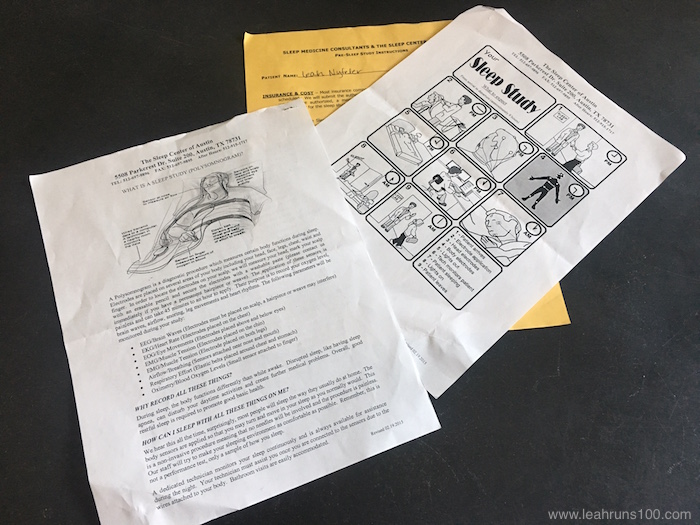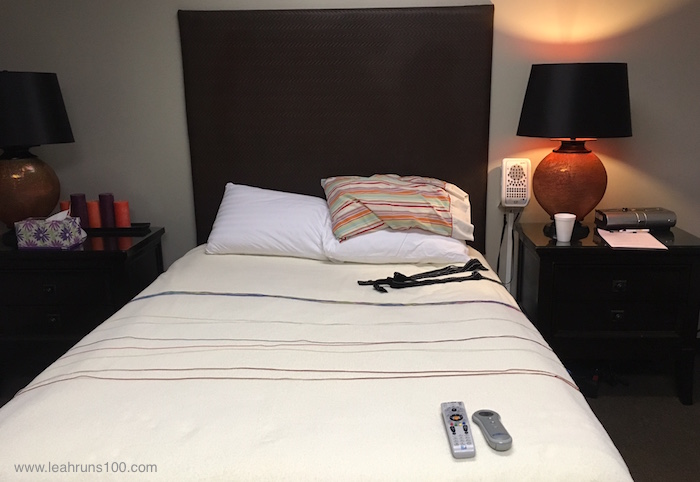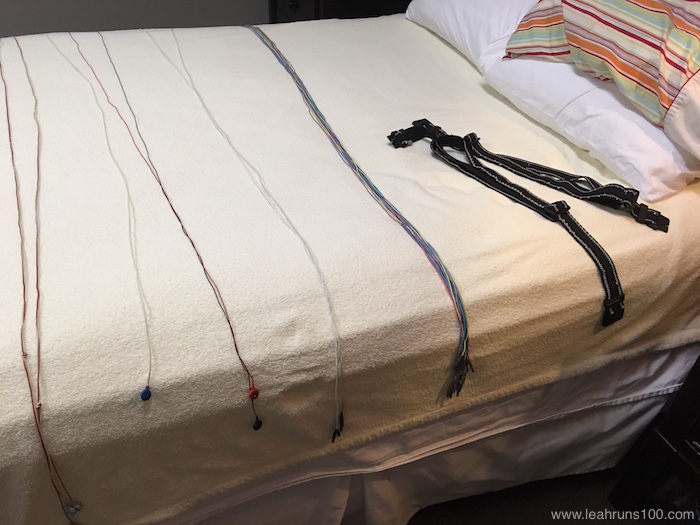When I hear “sleep study,” I immediately flash to the lab from “House,” where bored doctors watch a patient who’s lying on a gurney, hooked up to weird wires, through a hospital window. Or something totally scary, a la “The Haunting.”
Now that I’ve done one, however, I know neither scenario could be further from reality.
Why Have a Sleep Study?
 My doctor referred me to a sleep consultant as the next logical step in investigating my persistent fatigue (see “Too Tired to Run Means Something’s Wrong”). Perhaps I’ve been waking up tired and exhausted, she reasoned, because I’m never getting any quality sleep.
My doctor referred me to a sleep consultant as the next logical step in investigating my persistent fatigue (see “Too Tired to Run Means Something’s Wrong”). Perhaps I’ve been waking up tired and exhausted, she reasoned, because I’m never getting any quality sleep.
Being a bit skeptical, I almost didn’t make the appointment—my husband and various folks I’ve shared rooms with on overnight trips all say I don’t snore and hardly even move while sleeping. The first step, though, was to ascertain whether I was a good candidate for a study. Since the consultation was with a medical doctor certified in sleep medicine and pulmonology, I felt confident that my history would be competently reviewed and an appropriate decision reached.
Plus, I could always back out after getting a good look at things.
Setting Up That Sleep Study

A sleep study is a medical procedure known as polysomnography. The overnight test is used to determine a variety of disorders, from restless leg syndrome to apnea. The specialist (in my case, one of the doctors with Sleep Medicine Consultants) and the sleep study location, The Sleep Center of Austin, were partnered, though they were in different physical locations.
The sleep specialist went over my medical history and reviewed a questionnaire I’d completed in advance. The appointment at the doctor’s office lasted about 30 or so minutes, and we talked in depth about my fatigue and what the sleep study might reveal. He recommended I make an appointment for the study and prescribed a sleeping aid (“the last thing you want is to come in and not be able to go to sleep”).
The receptionist sent me home with detailed information about the actual procedure—what to wear, descriptions of what would be tested, and rules.
A few days later, The Sleep Center contacted me about cost ($600, applied toward my insurance deductible) and possible appointment dates. I took some time to consider–$600 is a lot of money—and then scheduled my study. As my husband pointed out, I need some answers and this is what our health account is for.
What Happens During a Sleep Study?

My appointment was for 10 p.m. on a Wednesday night. I was instructed to be clean and free of lotions, eat a light dinner, and bring my sleep aid medication. After my evening run, I came home, took a shower, and dressed in the clean clothes I wanted to wear Thursday morning. I packed modest pajamas—shorts and a long-sleeved T-shirt, because a technician needed to easily apply monitors and belts and the receptionist said the rooms were cold—and my favorite pillow. I always read for a few minutes before I go to sleep, so I also brought a book.
Once at the office, I rang the doorbell under the building’s awning; a voice from the intercom asked my name and then buzzed me in. The building was quiet; it’s strange and a little creepy to walk through an office hallway so late at night (perhaps I’ve been watching too many “Criminal Minds” episodes).
The technician, John, met me at the door. There were a few forms to initial and sign, and he confirmed I had brought my insurance card and sleep medicine. The bill was also due, so we got that out of the way.
The Sleep Center looked a lot more like a hotel than a lab. John showed me the bathrooms (complete with showers, towels, and amenities for those who’d go straight to work the next morning), coffee pot and snacks, and finally, the room where I’d be sleeping. He gave some instructions on the TV (yeah, I just turned it off—I hate a TV in the bedroom) and the Sleep Number adjustable bed (this was new to me, so I played around with the remote a bit). He excused himself so I could change.

I made a stop in the bathroom and slipped on my PJs, nervously putting on the robe I’d brought. It felt so weirdly intimate to sit on the bed, waiting for some guy I really didn’t know in what looked like a hotel room. John came back in and asked that I remove the robe and sit in a chair so he could connect electrodes to my lower legs, near each eye, and on my chin and chest. He also applied some goopy stuff to several spots on my scalp, nestling the electrodes amidst my hair. Each electrode also had a chord that attached, and he wended these skillfully around my PJs and monitors—I was wearing two stretchy fabric belts with sensors around my chest and stomach to measure “respiratory effort.” He worked quickly and methodically while explaining each piece of equipment’s function and putting me at ease with light conversation.
The last two items I put on were the most bothersome: a finger cap measuring blood oxygen levels (pulse oximeter) and the small plastic tubes that nestled inside each nostril with an additional sensor dangling over my mouth to measure airflow.
 Once everything was in place, John consolidated the cords into one neat rope, the ends plugged into a small electronic box at the head of the bed. He instructed me to lie down and then left the room to conduct a systems check (the secondary purpose, I’m sure, was to acquaint me with his disembodied voice in the dark). He instructed me to look left and right with my eyes, point my feet up and down, hold my breath, breathe through my nose and then mouth, and so on, testing that each of the monitors was working correctly.
Once everything was in place, John consolidated the cords into one neat rope, the ends plugged into a small electronic box at the head of the bed. He instructed me to lie down and then left the room to conduct a systems check (the secondary purpose, I’m sure, was to acquaint me with his disembodied voice in the dark). He instructed me to look left and right with my eyes, point my feet up and down, hold my breath, breathe through my nose and then mouth, and so on, testing that each of the monitors was working correctly.
When all systems were go, John returned to tuck me in. Literally—he adjusted the bed covers, asked if I needed anything, and then turned off the overhead light before closing the door behind him.
I was afraid to move much even though I’d been assured everything would stay put (help was required, though, if I’d need to get up during the night, but all I had to do was speak aloud to John and he’d assist). I tried to read, but the sleep aid–taken as we’d begun the sensor application process and equivalent to about two Benadryl tablets—made focusing difficult. I soon closed my book, turned off the bedside lamp, and settled in to sleep.
Sleep Hygiene: a variety of different practices necessary to have normal, quality nighttime sleep and full daytime alertness.
~National Sleep Foundation
We have our own idiosyncrasies when it comes to sleeping. For me, the room must be devoid of light—especially electronic light. Many a time my husband has laughed as I’ve scuttled around a hotel room, draping towels over various TV, refrigerator, and alarm clock lights. That electronic box by the head of the bed, the one all the cords plugged into? It emitted a red glow, one that seemed to pulse periodically. I groaned and attempted to turn so I couldn’t see it. The nostril tubes shifted when I lay on my side. The sleeping aid didn’t seem to be kicking in. Sigh. Grumble.
The next thing I knew, I heard John’s voice: “I’m going to need to come in to adjust your pulse oximeter.” I mumbled an “OK” before he tiptoed into the room to slide the cap more firmly onto my fingertip. There was no clock in the room, so I asked, “What time is it?” He said it was around 4 a.m.; I wondered if I’d fall sleep again before my 5-something alarm. I dozed fitfully until I heard John say, “It’s time to wake up.”
John returned to the room to reverse the previous night’s preparations. All the sensors were peeled off, each leaving a slightly sticky residue. I was so relieved to unbuckle the elastic belts; though they hadn’t really bothered me while I slept, it felt nice to draw unrestricted breath. I couldn’t shed that nose thing soon enough; John said most people found it to be the least pleasant aspect of the study.
Once all equipment was gone from my body, I was free to clean up and dress. The goop in my hair would require some dedicated effort to remove (John warned me not to touch it, as it would spread into a bigger mess) and I decided I’d rather work at that in the comfort of my home. As nice as the shower facilities were, I quickly dressed, collected my things, thanked John, and headed out the door.
So Now That The Sleep Study is Over…
 When I awoke Thursday morning, there was a short survey to complete. One item had me estimate how long I’d slept (my guess: 5 hours). Another asked whether anything had prevented me from a good night’s sleep, and I rated the quality of that night’s rest.
When I awoke Thursday morning, there was a short survey to complete. One item had me estimate how long I’d slept (my guess: 5 hours). Another asked whether anything had prevented me from a good night’s sleep, and I rated the quality of that night’s rest.
Perhaps I didn’t sleep that well; by late afternoon, I was barely able to stay awake. Exhausted, I skipped a fun event that evening because I wasn’t sure I could drive myself home safely. I dozed on the sofa while Hubby made dinner; sure enough, I was out like a light by 8:30 p.m.
The sleep specialist will review the test results and report his findings to me and my doctor. I wonder what I’ll discover. Do I talk in my sleep? How much did I move around? Can you hear me grind my teeth? Am I really as good a sleeper as I think I am?
And is a lack of sleep a factor in this lasting fatigue?
We’ll see.




2 thoughts on “What Happens In a Sleep Study (Spoiler: It’s Not That Scary)”